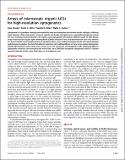Arrays of microscopic organic LEDs for high resolution optogenetics
Abstract
Optogenetics is a paradigm changing new method to study and manipulate the behavior of cells with light. Following major advances of the used genetic constructs over the last decade, the light sources required for optogenetic control are now receiving increased attention. Here, we report on a novel optogenetic illumination platform based on high density arrays of microscopic organic light emitting diodes (OLEDs). Due to the small dimensions of each array element (6x9 µm²) and the use of ultra-thin device encapsulation, these arrays enable illumination of cells with unprecedented spatiotemporal resolution. We show that adherent eukaryotic cells readily proliferate on these arrays and we demonstrate specific light-induced control of the ionic current across the membrane of individual live cells expressing different optogenetic constructs. Our work paves the way for the use of OLEDs for cell-specific optogenetic control in cultured neuronal networks, acute brain slices or as implants in vivo.
Citation
Steude , A , Witts , E C , Miles , G B & Gather , M C 2016 , ' Arrays of microscopic organic LEDs for high resolution optogenetics ' , Science Advances , vol. 2 , no. 5 , e1600061 . https://doi.org/10.1126/sciadv.1600061
Publication
Science Advances
Status
Peer reviewed
ISSN
2375-2548Type
Journal article
Description
We thank A. Morton and C. Murawski (both University of St Andrews) and B.Richter (Fraunhofer FEP, Dresden) for fruitful discussions. HEK-293 cells that were stably transfected with ChR2-H134R-EYFP DNA were provided by M. Antkowiak and F. J. Gunn-Moore (both University of St Andrews). Funding: This work was supported by the Scottish Funding Council (via Scottish Universities Physics Alliance), the Human Frontier Science Program (RGY0074/2013), and the RS Macdonald Charitable Trust. Author contributions: A.S. performed the optogenetics experiments and data analysis. E.C.W. and G.B.M. carried out the patch clamp measurements. M.C.G. conceived and supervised the project. A.S. and M.C.G. jointly wrote the manuscript with input from all authors. Competing interests: The authors declare that they have no competing interests. Data and materials availability: All data needed to evaluate the conclusions in the paper are present in the paper. The research data supporting this publication can be accessed at DOI 10.17630/d758df2c-78ee-482c-ae7f-af37b00fdb52. Additional data related to this paper are available upon request from M.C.G. (mcg6@st-andrews.ac.uk).Collections
Items in the St Andrews Research Repository are protected by copyright, with all rights reserved, unless otherwise indicated.

